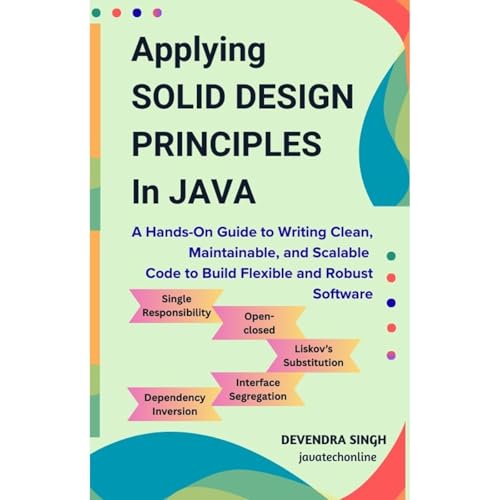
Applying SOLID Design Principles in Java
A Hands-On Guide to Writing Clean, Maintainable, and Scalable Code to Build Flexible and Robust Software
No se pudo agregar al carrito
Solo puedes tener X títulos en el carrito para realizar el pago.
Add to Cart failed.
Por favor prueba de nuevo más tarde
Error al Agregar a Lista de Deseos.
Por favor prueba de nuevo más tarde
Error al eliminar de la lista de deseos.
Por favor prueba de nuevo más tarde
Error al añadir a tu biblioteca
Por favor intenta de nuevo
Error al seguir el podcast
Intenta nuevamente
Error al dejar de seguir el podcast
Intenta nuevamente
$0.00 por los primeros 30 días
Escucha audiolibros, podcasts y Audible Originals con Audible Plus por un precio mensual bajo.
Escucha en cualquier momento y en cualquier lugar en tus dispositivos con la aplicación gratuita Audible.
Los suscriptores por primera vez de Audible Plus obtienen su primer mes gratis. Cancela la suscripción en cualquier momento.
Compra ahora por $4.99
-
Narrado por:
-
Virtual Voice
-
De:
-
Devendra Singh

Este título utiliza narración de voz virtual
Voz Virtual es una narración generada por computadora para audiolibros..
You're not alone. These are common problems, and the SOLID design principles are here to help. SOLID is a set of five rules that guide us to create software that is easier to understand, change, and expand. It helps you build a strong foundation for your projects.
This book is designed to be your friendly, practical guide. We focus on doing, not just theory. We know that the best way to learn is by seeing examples and getting your hands dirty with code. Our mission is to move you from conceptual understanding to practical mastery.
What Will You Find in This Book & What Makes This Book Different?
- Step-by-Step Learning: The book is set up to build your knowledge one step at a time, starting with the basics and moving to more complex designs.
- Real-World Code Examples, Not Just Theory: Each principle is explained through clear, relatable real-world Java examples. For each principle, we first show you what not to do with code you might recognize. Then, we show you step-by-step how to fix it into a better, cleaner solution.
- Helpful Visuals/Pictures: We use simple intuitive UML diagrams and other visuals to explain how the code is changing. These diagrams provide a at-a-glance understanding of the design transformations we discuss, catering to visual learners and reinforcing the structural changes. If you're a visual learner, these will make the ideas click.
- Test Your Knowledge & Understanding: We've included 100 multiple-choice questions (MCQs) to help you practice. Each question comes with a detailed explanation of every answer, so you can learn from your mistakes and feel confident in your knowledge. These aren't just simple recall questions; they are designed to challenge your understanding, present nuanced scenarios, and pit good design against great design.
This book is for anyone who knows basic Java and wants to write better code. If you are a student, a beginner, or a programmer who has heard about SOLID but finds it confusing, this book is for you. It's your first step toward becoming a better software developer. This book is for anyone who wants to build better software and understand the thinking behind how systems are created. It's written for:
- The Newcomer: If you're just starting and want to learn how to make systems reliable and scalable, this book will give you a solid and easy-to-understand foundation.
- The Experienced Engineer: If you're getting ready for an interview, this book is your go-to guide. It covers all the key ideas including solved interview questions and gives you real-world examples to help you feel confident in your answers.
- The Senior Architect: For those who already have a lot of experience, this book can be a great reference to refresh your knowledge and stay up-to-date with the latest trends and patterns.
- Anyone wants to learn Design Principles & write a better code: For those who want to learn how to write Clean, Maintainable, and Scalable Code to Build Flexible and Robust Software.
Todavía no hay opiniones


